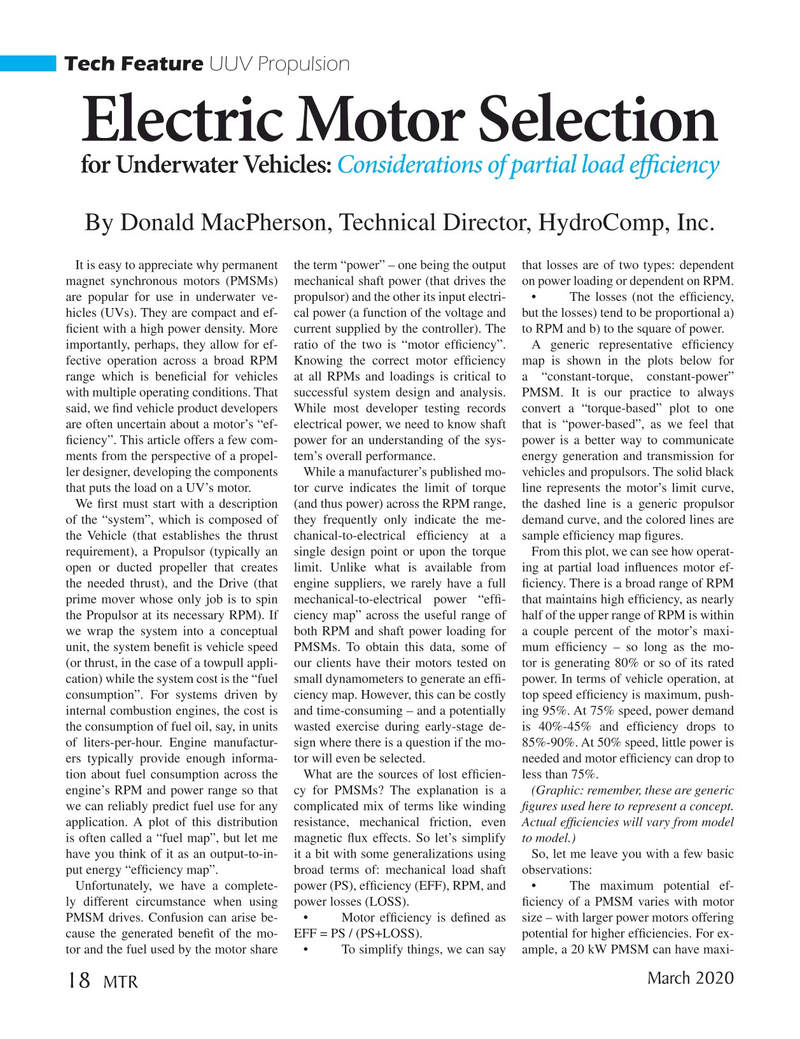
Page 18: of Marine Technology Magazine (March 2020)
Read this page in Pdf, Flash or Html5 edition of March 2020 Marine Technology Magazine
Tech Feature UUV Propulsion
Electric Motor Selection for Underwater Vehicles: Considerations of partial load ef ciency
By Donald MacPherson, Technical Director, HydroComp, Inc.
It is easy to appreciate why permanent the term “power” – one being the output that losses are of two types: dependent magnet synchronous motors (PMSMs) mechanical shaft power (that drives the on power loading or dependent on RPM.
are popular for use in underwater ve- propulsor) and the other its input electri- • The losses (not the ef? ciency, hicles (UVs). They are compact and ef- cal power (a function of the voltage and but the losses) tend to be proportional a) ? cient with a high power density. More current supplied by the controller). The to RPM and b) to the square of power.
importantly, perhaps, they allow for ef- ratio of the two is “motor ef? ciency”. A generic representative ef? ciency fective operation across a broad RPM Knowing the correct motor ef? ciency map is shown in the plots below for range which is bene? cial for vehicles at all RPMs and loadings is critical to a “constant-torque, constant-power” with multiple operating conditions. That successful system design and analysis. PMSM. It is our practice to always said, we ? nd vehicle product developers While most developer testing records convert a “torque-based” plot to one are often uncertain about a motor’s “ef- electrical power, we need to know shaft that is “power-based”, as we feel that ? ciency”. This article offers a few com- power for an understanding of the sys- power is a better way to communicate ments from the perspective of a propel- tem’s overall performance. energy generation and transmission for ler designer, developing the components While a manufacturer’s published mo- vehicles and propulsors. The solid black that puts the load on a UV’s motor. tor curve indicates the limit of torque line represents the motor’s limit curve,
We ? rst must start with a description (and thus power) across the RPM range, the dashed line is a generic propulsor of the “system”, which is composed of they frequently only indicate the me- demand curve, and the colored lines are the Vehicle (that establishes the thrust chanical-to-electrical ef? ciency at a sample ef? ciency map ? gures. requirement), a Propulsor (typically an single design point or upon the torque From this plot, we can see how operat- open or ducted propeller that creates limit. Unlike what is available from ing at partial load in? uences motor ef- the needed thrust), and the Drive (that engine suppliers, we rarely have a full ? ciency. There is a broad range of RPM prime mover whose only job is to spin mechanical-to-electrical power “ef? - that maintains high ef? ciency, as nearly the Propulsor at its necessary RPM). If ciency map” across the useful range of half of the upper range of RPM is within we wrap the system into a conceptual both RPM and shaft power loading for a couple percent of the motor’s maxi- unit, the system bene? t is vehicle speed PMSMs. To obtain this data, some of mum ef? ciency – so long as the mo- (or thrust, in the case of a towpull appli- our clients have their motors tested on tor is generating 80% or so of its rated cation) while the system cost is the “fuel small dynamometers to generate an ef? - power. In terms of vehicle operation, at consumption”. For systems driven by ciency map. However, this can be costly top speed ef? ciency is maximum, push- internal combustion engines, the cost is and time-consuming – and a potentially ing 95%. At 75% speed, power demand the consumption of fuel oil, say, in units wasted exercise during early-stage de- is 40%-45% and ef? ciency drops to of liters-per-hour. Engine manufactur- sign where there is a question if the mo- 85%-90%. At 50% speed, little power is ers typically provide enough informa- tor will even be selected. needed and motor ef? ciency can drop to tion about fuel consumption across the What are the sources of lost ef? cien- less than 75%.
engine’s RPM and power range so that cy for PMSMs? The explanation is a (Graphic: remember, these are generic we can reliably predict fuel use for any complicated mix of terms like winding ? gures used here to represent a concept. application. A plot of this distribution resistance, mechanical friction, even Actual ef? ciencies will vary from model is often called a “fuel map”, but let me magnetic ? ux effects. So let’s simplify to model.) have you think of it as an output-to-in- it a bit with some generalizations using So, let me leave you with a few basic put energy “ef? ciency map”. broad terms of: mechanical load shaft observations:
Unfortunately, we have a complete- power (PS), ef? ciency (EFF), RPM, and • The maximum potential ef- ly different circumstance when using power losses (LOSS). ? ciency of a PMSM varies with motor
PMSM drives. Confusion can arise be- • Motor ef? ciency is de? ned as size – with larger power motors offering cause the generated bene? t of the mo- EFF = PS / (PS+LOSS). potential for higher ef? ciencies. For ex- tor and the fuel used by the motor share • To simplify things, we can say ample, a 20 kW PMSM can have maxi-
March 2020 18 MTR
MTR #2 (18-33).indd 18 MTR #2 (18-33).indd 18 2/27/2020 9:20:47 AM2/27/2020 9:20:47 AM

 17
17

 19
19
